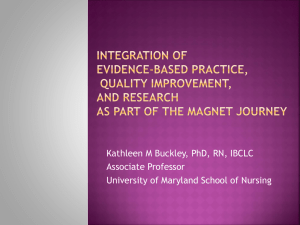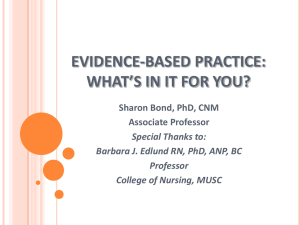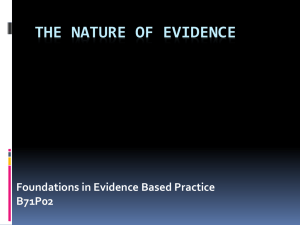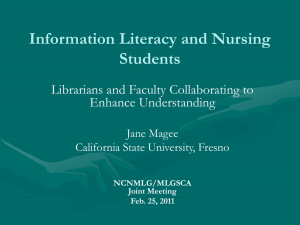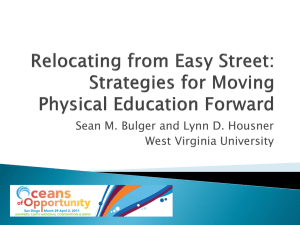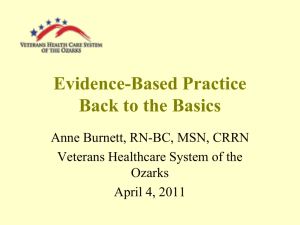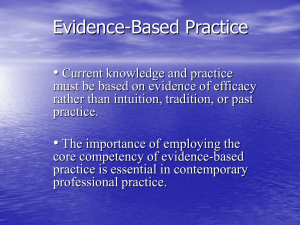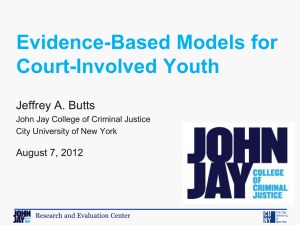UAB School of Nursing Power Point Template
advertisement
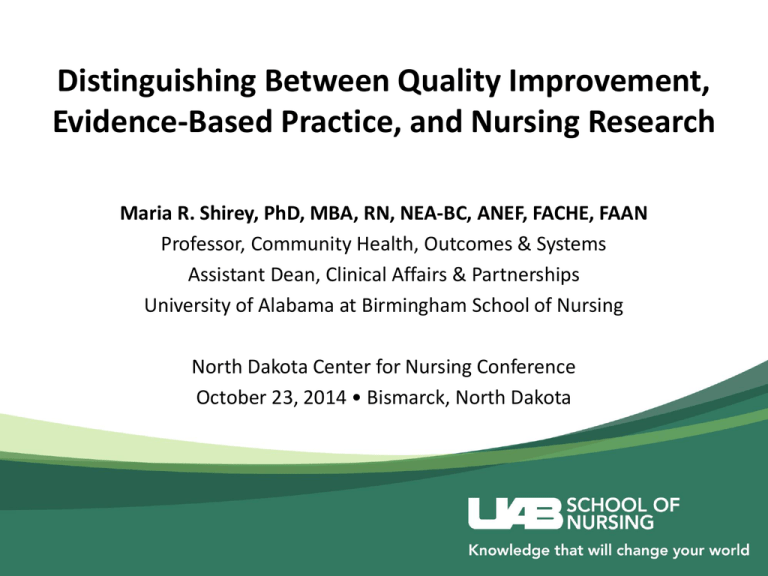
Distinguishing Between Quality Improvement, Evidence-Based Practice, and Nursing Research Maria R. Shirey, PhD, MBA, RN, NEA-BC, ANEF, FACHE, FAAN Professor, Community Health, Outcomes & Systems Assistant Dean, Clinical Affairs & Partnerships University of Alabama at Birmingham School of Nursing North Dakota Center for Nursing Conference October 23, 2014 • Bismarck, North Dakota Introduction 2 2 3 So … How Did You Get Here? “Showcasing Differences Between Quality Improvement, Evidence-Based Practice, and Research” Winner of the inaugural JCEN Innovation Award for 2011 Shirey et al., (2011) 4 Impact 5 Presentation Objectives • Differentiate among quality improvement (QI), evidence-based practice (EBP), and nursing research Realistic Expectation: Gain general understanding of concepts and their application Reflect and brainstorm to use information more broadly 6 Road Map • Overview of the Shirey et al., (2011) article • Application of article by others • Reflective dialogue with next steps • Key takeaways with Q&A 7 Overview of the Article 8 Why Is There Need to Know? • Recent meta-analysis identified all concepts as essential for Magnetic, healthy nursing workplace (Kramer, Schmalenberg & Maguire, 2010) Research Quality & Safety of Patient Care QI EBP 9 Important Definitions Quality Improvement Data driven systematic approach by which individuals work together to improve specific internal systems, processes, costs, productivity, and quality outcomes with an organization Note: Terms QI and Performance Improvement (PI) used interchangeably 10 Important Definitions Evidence-Based Practice Problem-solving approach that integrates a systematic search for and critical appraisal of the best available evidence (may or may not be research based) to answer a burning clinical, education, or administrative question Clinician expertise and patients’ unique circumstances and preferences 11 Important Definitions Research Scientific process that generates new knowledge and validates/refines existing knowledge that directly and indirectly influences nursing practice or health systems 12 Background and Overview of the Article • Started as discussion board assignment in DNP course • Intent of assignment was to compare and contrast all 3 concepts of QI, EBP, Research across multiple dimensions • No article available with extensive side-by-side comparative data, so … we created one!!! 13 Building The Comparative Table Synthesis of the Literature Main Categories QI EBP Background and descriptors Uses and Applications Scholarship Integration Shirey et al. (2011) 14 Research Highlights of Comparative Table Main Categories with Dimensions QI EBP Research Deming; production quality monitoring Cochrane; scientific evidence used to guide practice Nightingale; scientific method of discovery in nursing • Commonalities and distinctions Systematic problem solving approach that is data driven Systematic problem solving approach that is evidence driven Systematic problem solving approach that is inquiry driven • Key features Incorporates knowledge Translates knowledge Generates knowledge • Rigor Least rigorous Somewhat rigorous Most rigorous Background and descriptors • Historical evolution 15 Highlights of Comparative Table Main Categories with Dimensions QI EBP Improve internal processes to enhance outcomes Evaluate evidence and Develop new integrate into practice knowledge that is to enhance outcomes generalizable • Use of protocols Yes; changing Yes; systematic Yes; strict • Data collection Rapid cycle Intermediate not rapid cycle Not rapid cycle • IRB approval Not usually; may be needed for pubs Not usually; may be needed for pubs Always; required for publication and to initiate study Uses and Applications • Purpose 16 Research Highlights of Comparative Table Main Categories with Dimensions QI EBP Research Uses and Applications • Funding Usually internal Usually internal May be internal or external • Oversight Institutional Institutional Beyond institution • Limitations Weak methodology; no causality Outcome only as good as “best” evidence Depending on analysis can establish causality • Methodology Various QI approaches i.e. PDCA Various EBP models i.e. ARCC model (Melnyk & FineoutOverholt) Various methodologies i.e. qualitative, quantitative or mixed methods 17 Highlights of Comparative Table Main Categories with Dimensions Uses and Applications • Examples QI EBP Research PDCA project to improve door to balloon times in acute myocardial infarction patients Implementation of protocol for early post operative patient ambulation following release of landmark systematic review Qualitative research to describe nurse manager work complexity PDCA project to reduce 30-day hospital readmission rates in heart failure patients Translation of best evidence into practice to enhance outcomes 18 Highlights of Comparative Table Main Categories with Dimensions QI EBP Research No Varies Usually yes • Generalizability No Yes, with caveat Yes, with caveat • Expectations for dissemination Within facility Within facility and beyond Broad dissemination to scientific community • Potential for dissemination May be publishable May be publishable Usually publishable Scholarship Integration • Theoretical underpinnings 19 Highlights of Comparative Table Main Categories with Dimensions Scholarship Integration • Examples of venues for publication • Examples of venues for presentations QI EBP Research Journal for Healthcare Quality Worldviews on Evidence-Based Practice Nursing Research NAHQ conferences EBP conferences Nursing research society conferences 20 Understanding Check 21 Understanding Check Question #1 If the intent of a project is to establish a cause-andeffect relationship, the best approach to use would be a/an: A. Evidence-Based Practice Project. B. Quality Improvement Project. C. Research Project. D. Institutional Project. 22 Understanding Check Question #2 Given the following choices to develop an EBP project, the best methodology to use would be: A. Six Sigma. B. Plan Do Check Act. C. The Academic Model. D. The Iowa Model. 23 Understanding Check Question #3 Given the choice between various approaches, a team developing a clinical work flow process using limited resources and time would likely select: A. Nursing Research. B. Evidence-Based Practice. C. Quality Improvement. D. Clinical Inquiry. 24 Understanding Check Question #4 The definitive dimension the distinguishes between quality improvement, evidence based practice, and research is: A. Historical Evolution. B. Definition. C. Rigor. D. Purpose. 25 Application of the Article 26 The Application Tool for Academia • Guide for teaching QI, EBP, Research in academic programs • Incorporated in teaching QSEN principles (American Association of Colleges of Nursing QSEN Institute Faculty Resources) • Referenced in numerous professional websites 27 The Application Tool for Clinical Nursing Excellence • Support Nursing Standards of Practice (ANA, 2010) At fundamental level, the registered nurse participates in QI activities and integrates EBP and research into practice • Accelerate Hospital Magnet Journey → Guide to decipher which approach to use → Identify need for IRB approval → Create Magnet evidence • Form foundation for additional user-friendly staff development resources for clinical practice (Ryan & Rosario, 2012) 28 The Application Tool for Clinical Nursing Excellence Performance Improvement/Research Differentiation Form (Ryan & Rosario , 2012) • Identify title of project • Answer series of questions • Determine pattern of responses • Identify emerging dominant study category 29 Ryan & Rosario (2012) Performance Improvement Research Which phrase best describes purpose of the project? To improve internal organizational processes, practices, costs or productivity To generate new knowledge that can be generalized What are you trying to accomplish with this project? To measure an existing practice that is an approved procedure or that has been shown effective in the literature *** To test or refine an innovative practice or instrument Will participants be placed at any risk during project? The project does not impose risks beyond usual care *** The project may impose some risk to participants 30 Uncertain Ryan & Rosario (2012) Performance Improvement Research What does the intervention in this project involve? The project involves applying practice standards or evaluating existing practice without group comparisons The project involves comparisons of one or more interventions that are given to some patients and not others How are the processes or outcomes measured? A data collection tool that has not been tested for reliability and validity is used An instrument that is a valid and reliable measure of the concept to be tested will be used What do you plan to do with the findings? Communicate findings within the hospital or department setting. Findings may be published and/or presented. Publish and/or present findings for others within the discipline How will your findings change practice? May change practice in this setting immediately May change practice slowly, often after multiple studies validate the results 31 Uncertain The Application Tool for Dissemination Different Formats for Publication of QI, EBP, Research Oermann, Turner & Carman (2014) QI SQUIRE Research EBP IMRAD PRISMA Guidelines for Reporting 32 Guideline Definition and Website Resource QI SQUIRE Standards for Quality Improvement Reporting Excellence http://squire-statement.org/ Title, Abstract, Introduction, Methods, Results, Discussion, Other Information EBP PRISMA Preferred Reporting Items for Systematic Reviews and Meta-Analyses http://www.prisma-statement.org/ Title, Abstract, Introduction, Methods, Results, Discussion, Funding Research IMRAD Introduction, Methods, Results, and Discussion Title, Abstract, http://writingwisc.edu/Handbook/ScienceReport. Introduction, html Methods, Results, Discussion, Limitations, Conclusions, Implications, Funding The Application Tool for Dissemination 33 Categories Application Check 34 Application Check Scenario #1: QI • The hospital examines its monthly run charts on key quality indicators • In reviewing these data, the hospital determines the incidence of falls in hospitalized elderly patients is trending upward • To act on this information, what should happen next? 35 Application Check Scenario #1: QI • Formulate QI question: Why is the unit level fall rate so high? • Apply QI methodology P Identify and analyze problem D Develop and test solutions C Check effect of pilot solution A Implement solution fully 36 Application Check Scenario # 2: EBP • There is a desire to initiate a practice change that would prevent falls in hospitalized elders • To initiate a practice change, what should happen first? 37 Application Check Scenario # 2: EBP • Formulate clinical question using PICOT format: P Population I Intervention C Comparison O Outcome T Timeframe In hospitalized elders (P), how does a bed alarm (I) compared to use of sitters (C) affect fall rates (O) during a 3 month time period (T)? 38 Application Check Scenario # 2: EBP • Specify key search terms to retrieve evidence that best answers PICOT question and meets inclusion criteria • Generate evidence table and determine level of evidence • Critically appraise the evidence (look at flaws and worth) • Make practice recommendations based on best evidence 39 Application Check Level 1- Systematic review & meta-analysis of RCT Level 2- One or more randomized controlled trials Level 3- Controlled trial (no randomization) Level 4- Case control or cohort study Level 5- Systematic review of descriptive & qualitative studies Level 6- Single descriptive or qualitative study Level 7- Expert opinion Melnyk & Fineout-Overholt (2011) 40 Application Check Scenario # 3: Research • You have searched the literature to obtain information about the incidence of falls in hospitalized elders • You find the literature is not current and it does not incorporate cultural aspects pertinent to your unique elderly patient population • How do you go about developing a permanent solution for elderly patient falls in your patient population? 41 Application Check Scenario # 3: Research • Identify problem statement • Formulate research question: What factors contribute to falls in non-English speaking hospitalized elderly patients? • Use research question to guide methodology (design, sampling, data collection, data analysis methods) 42 Reflection with Next Steps 43 Stretch and Energize to Focus 44 Reflective Question Now that you have heard this presentation, what ideas do you have for HOW you would immediately begin using the information in your practice and work setting? 45 Think, Pair & Share • Turn to person next to you • Discuss the following for 5-minutes: How would you begin to immediately use the information from this presentation in your practice and/or work setting? What partnerships or networks might you leverage? Why? • Take 5-minutes to share your ideas with the broader audience 46 Synthesis Check 47 Key Takeaway Points • Correctly differentiating among QI, EBP, and research = → Essential for patient care quality/safety → Needed to advance nursing practice and science • Understanding concept differences enhances applicability, integration, collaboration opportunities, and ultimately our IMPACT • Proficiency comes from learning and doing 48 Closing 49 Questions & Answers Maria R. Shirey, PhD, MBA, RN, NEA-BC, ANEF, FACHE, FAAN Professor, Community Health, Outcomes & Systems Assistant Dean, Clinical Affairs & Partnerships University of Alabama at Birmingham School of Nursing mrshirey@uab.edu 50 References American Nurses Association. (2010). Nursing scope and standards of practice. Washington, DC: ANA. Kramer, M., Schmalenberg, C.& & Maguire, P. (2010). Nine structures and leadership practices essential for a magnetic (healthy) work environment. Nursing Administration Quarterly, 34(1), 4-17. Melnyk, B. & Fineout-Overholt, E. (2011). Evidence-based practice in nursing and healthcare: A guide to best practice. Philadelphia: Lippincott, Williams & Wilkins. 51 References Oermann, M.H., Turner, K. & Carman, M. (2014). Preparing quality improvement, research, and evidence-based practice manuscripts. Nursing Economic$, 32(2), 57-69. Ryan, M. & Rosario, R. (2012). Creating staff confidence in distinguishing between performance improvement and research studies: A user-friendly worksheet. Journal of Nursing Administration, 42 (7/8), 369-374. Shirey, M. R., Hauck, S. L., Embree, J. L., Kinner, T. J., Schaar, G. L., Phillips, L. A., Ashby, S. R., Swenty, C. F., & McCool, I. A. (2011). Showcasing differences between quality improvement, evidence-based practice, and research. The Journal of Continuing Education in Nursing, 42(2), 57-70. 52
